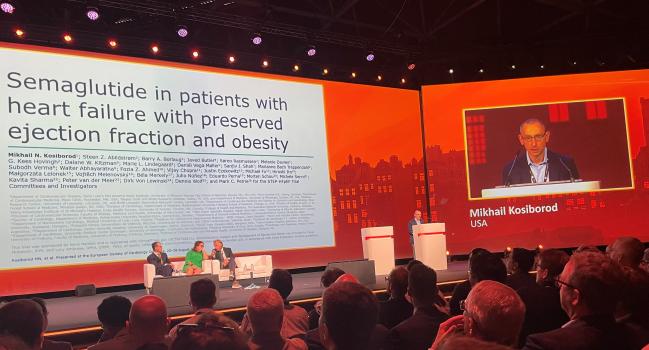STEP-HFpEF: Semaglutide Cuts Weight and Symptoms, Boosts Function
(UPDATED) The benefits come amid positive shifts for CRP and NT-proBNP, suggesting more than weight loss is at play, the PI says.

AMSTERDAM, the Netherlands—It’s no surprise that injectable semaglutide leads to significant weight loss among obese heart failure patients with preserved ejection fraction (HFpEF), but as the STEP-HFpEF trial showed here today, the once-weekly shot also significantly reduces HF-related symptoms and inflammatory markers, while improving physical function.
Both the weight loss and the improvements in Kansas City Cardiomyopathy Questionnaire clinical summary score (KCCQ-CSS)—the trial’s dual primary endpoints—were markedly better in the semaglutide-treated patients than placebo-treated controls.
“This is actually the largest KCCQ clinical summary score benefit ever seen with any drug in HFpEF,” principal investigator Mikhail Kosiborod, MD (Saint Luke’s Mid America Heart Institute, Kansas City, MO), who presented the results during the opening Hot Line session of the European Society of Cardiology (ESC) Congress 2023, told TCTMD.
These eagerly anticipated results should carve out a role for the glucagon-like peptide-1 (GLP-1) receptor agonist as a “valuable therapeutic approach” in the management of HFpEF patients,” he said.
STEP-HFpEF was widely predicted to be positive based on other recent news. Announced earlier this month, top-line results from the SELECT study showed that semaglutide (Wegovy; Novo Nordisk) cuts the risk of major adverse cardiovascular events in adults with overweight or obesity, with all components of that endpoint showing gains. Moreover, as Kosiborod reminded his ESC audience, the majority of HFpEF patients have overweight or obesity, with this particular phenotype having unique clinical and hemodynamic features that convey “an especially high burden of symptoms and functional impairment.”
No other approved therapies in HFpEF specifically target the obesity phenotype, he added.
The drug is already approved around the world as an adjunct to diet and exercise for chronic weight management in adults and pediatric patients 12 and older with obesity, as well as adults with overweight and at least one weight-related comorbidity, leading to its wild popularity and drug shortages. It is marketed as Ozempic for glycemic control in type 2 diabetes.
Attendees of the ESC Hot Line session today greeted the results warmly, with discussant Frank Ruschitzka, MD (University Heart Center, Zurich, Switzerland), calling STEP HFpEF “a strong stride forward into a new era, no question: . . . fantastic science that matters big-time.”
With 32 million people worldwide affected with HFpEF, he continued, these results will leave a mark.
Eugene Yang, MD (University of Washington, Bellevue), chair of the American College of Cardiology’s Prevention Council, speaking with TCTMD, was also positive about the trial findings and pointed out that symptoms are often what matters most to patients. Still, he had some words of caution.
As clinicians, as cardiologists, we care about how patients feel. Eugene Yang
“As clinicians, as cardiologists, we care about how patients feel, so if they subjectively feel better in terms of symptomology, then that's a great thing. On the other hand, from the perspective of risk-benefit and cost-effectiveness, this study doesn't address that,” he cautioned. “The reality is that it was not powered to look at outcomes. And so all we can say is that based on these subjective questionnaires and some biomarkers, yes, this is a great step forward.”
Ultimately, he predicted, it will be payers, not symptom relief, that guides usage, and that will likely require hard outcome data. “Until we have that we do need to, I think, temper our enthusiasm,” said Yang.
STEP-HFpEF Details
The trial randomized 529 patients with a left ventricular ejection fraction ≥ 45% and impaired function to a 2.4-mg weekly, subcutaneous injection of semaglutide or placebo over a 16-week dose-escalation period, followed by another 36 weeks of treatment, with follow-up conducted between week 52 and 57. Most patients had NYHA class II heart failure, without approximately one-third with class III or IV symptoms, Kosiborod clarified.
Importantly, since the drug is already approved in diabetes, patients with known diabetes or HbA1c ≥ 6.5% were excluded, as were any with prior or planned bariatric surgery. A sister trial, known as STEP-HFpEF DM, is ongoing, Kosiborod noted.
At 52 weeks, KCCQ-CSS improved from baseline in both groups, but to a significantly greater degree in the semaglutide group: 16.6 versus 8.7 points, an estimated treatment difference (ETD) of 7.8 points (95% CI 4.8-0.9). The benefits on KCCQ were evident within the first 20 weeks, but continued to improve further from there, Kosiborod noted.
The last trial to show such a marked benefit in KCCQ scores was PRESERVED-HF, which showed a 5.8-point difference with the sodium-glucose cotransporter 2 inhibitor (SGLT2) dapagliflozin. To TCTMD, Kosiborod, who also led that trial, called that “a bit of an outlier,” noting that other trials of SGLT2 inhibitors in HF have typically demonstrated differences in KCCQ-CCS scores in the range of 2 to 3 points. In EMPEROR-Preserved, for example, the difference in scores at 52 weeks was just 1.5 points between empagliflozin- (Jardiance; Boehringer Ingelheim/Eli Lilly) and placebo-treated patients.
Body weight “not surprisingly,” said Kosiborod, fell only marginally in the placebo-treated patients (by 2.6%), but dropped by 13.3% in the patients treated with semaglutide, an ETD of 10.7% (95% CI 9.4%-11.9%), a highly significant difference with a P value that had nine zeros, Kosiborod stressed.
Other secondary endpoints also markedly favored semaglutide:
- Six-minute walk distance improved to a greater degree (by 21.5 vs 1.2 m; ETD 20.3 m; 95% CI 8.6-32.1)
- Mean percent reduction in C-reactive protein (CRP) was greater (by 43.5% vs 7.3%; estimated treatment ratio 0.61; 95% CI 0.51-0.72)
- The drop in NT-proBNP levels from baseline was greater (more than 20% vs roughly 5%; estimated treatment ratio 0.84; 95% CI 0.71-0.98)
This last, Kosiborod said, is striking, given the controversy over the relationship between NT-proBNP and obesity sowed by prior trials: typically the higher the body mass index (BMI), the lower the NT-proBNP. “We've never previously had data about what happens to NT-proBNP in patients that have heart failure but are also obese and have elevated NT-proBNP at baseline,” he said. “So this is the first data of its kind that's ever actually been shown, and as you can see, patients treated with semaglutide had a significantly greater reduction in NT-proBNP despite pretty massive weight loss.”
In terms of safety, overall serious adverse events were lower in semaglutide patients, driven largely by the lower rate of “cardiac disorders” in semaglutide- versus placebo-treated patients (2.7% vs 11.3%); however, study discontinuation due to adverse events, most notably gastrointestinal adverse events—a known problem with semaglutide—was more common among those on active treatment (13.3% vs 5.3%).
Asked about suicidal ideation—a signal currently under investigation by European regulators—Kosiborod said they have seen no worrisome signals to date.
Key Step Forward
The key question for many will be whether the weight loss is driving the benefit or whether there are other effects of the agent at play.
“We’ve known for a long time that obesity, adiposity, and insulin resistance—this constellation of cardiometabolic abnormalities that happens in the very large proportion of people with HFpEF—is likely not just a comorbidity, but it's a root cause of the development and progression of heart failure to begin with in this patient population and should be targeted,” Kosiborod said. “But, of course, it's never been done before. So this is the first demonstration of what can happen when you actually directly target obesity in people that have what we believe is obesity-related, obesity-mediated HFpEF. And these NT-proBNP and clinical events data I think are strongly suggestive, strongly supportive, of the notion that it's not just weight loss, but when you treat these patients with these types of agents in addition to weight loss, which probably has its direct benefits, you have a number of other known weight loss-related effects that actually happen simultaneously.”
That is supported by indications of a decongestive effect, supported by the NT-proBNP numbers, as well as the signal of fewer cardiac events in semaglutide-treated patients, although this endpoint was not powered, he said. “I think [this] is very tantalizing, even though it's based on a small number of events, that strongly suggests that it's a disease-modifying therapy.”
Speaking with TCTMD, study steering committee member, Subodh Verma, MD, PhD (St. Michael’s Hospital/University of Toronto, Canada), speculated that pleiotropic effects of semaglutide, including decongestant effects, may be helping heart function or that the weight loss alone may be the key driver, but this likely isn’t very important to patients.
“At the end of the day, whether it's weight reduction that's driving the mechanism for benefit or not, the fact that these are people who have a benefit that is of an order of magnitude greater than any other strategy that we've had in the treatment of heart failure with respect to the outcomes that we're studying, I think really opens up a whole new, potential avenue for treatment,” Verma said.
Prior to the SGLT2 inhibitor studies, there have been no drugs that have moved the needle in HFpEF, and this is the first directly targeting the obesity phenotype, Verma stressed. “It's a total win for patients and hopefully it will encourage individuals to do larger trials. KCCQ outcomes are very well validated for clinical outcomes, but they are still not hard endpoints—there will be the need for hard endpoint trials in the future.”
[It's a strong stride forward into a new era, no question: . . . fantastic science that matters big-time. Frank Ruschitzka
In an editorial accompanying the study’s simultaneous publication in the New England Journal of Medicine, Yigal M. Pinto, MD, PhD (Amsterdam UMC, University of Amsterdam, the Netherlands), also delves into the need for hard endpoint studies, as well as research to gain a deeper understanding of how the effects of GLP-1 agonism compare to SGLT2 inhibition. Notably, writes Pinto, semaglutide in this study was associated with a nonsignificantly lower number of hospitalizations or urgent heart failure visits.
“The encouraging findings for semaglutide in patients with heart failure with preserved ejection fraction reported here potentially add a much needed extra option for these patients and provide another upstream treatment for patients with signs of this condition plus a high BMI,” Pinto writes.
Both STEP-HFpEF and STEP-HFpEF DM are designed for regulatory approval of new indications based on symptoms and improvements in physical functioning, not hard outcomes, Kosiborod told TCTMD. Most patients would already quality for this agent on the basis of their obesity alone. What might change, he predicted, is that SELECT and the STEP trials might motivate payers, most of whom do not cover semaglutide for weight loss.
“We will need to have some serious conversations,” he said, adding that the argument no longer holds up that obesity is a “cosmetic issue.”
“Clearly, it's not. It's clearly a disease, and it clearly needs to be treated just like any other chronic disease,” stressed Kosiborod. These types of benefits: a 20% reduction in MACE [in SELECT] and the largest improvement in symptoms and physical limitation ever seen with a drug in this disease condition—will you have any credibility if you continue to refuse covering it now?”
[Obesity is] clearly a disease and it clearly needs to be treated just like any other chronic disease. Mikhail Kosiborod
The drug is expensive: according to a Novo Nordisk spokesperson the US list price is $1,349.02 for a 28-day supply (four pens, dosed once weekly). Patients whose insurance does not cover it, they added, “are eligible to use a savings offer to receive $500 off for each 28-day refill.”
To TCTMD, Verma mused that, in an ideal world, researchers, sponsors, and payers would also be focusing on prevention. “If you could treat obesity earlier, before the obesity-related complications ensue, which includes heart failure, which includes atherosclerosis, which includes all of the other issues that come along with overweight and obesity, then that can reduce morbidity for patients, make life more livable, and extend life. It’s also more cost-saving, too, I would argue. But, that's a bigger and broader conversation.”
Calling himself a “Debbie Downer,” Yang, too, stressed that the problem of obesity in heart failure patients is a worldwide problem worthy of more than a new blockbuster drug. GLP-1 agents are, for many, prohibitively expensive and may only widen the gaps inherent in social determinants of health.
“I'm a preventive cardiologist, so I want people to improve their health through lifestyle modification. But patients prefer to take a pill, prefer to get renal denervation, as opposed to actually doing the work to improve their health. So everything else is sort of a stopgap,” he said. “If we could do a better job and, instead of spending billions of dollars on all these new drugs, invest that money through things like the World Heart Federation and other societies to actually really influence behavioral changes and primordial prevention—that's really where we need the investment.”
Shelley Wood was the Editor-in-Chief of TCTMD and the Editorial Director at the Cardiovascular Research Foundation (CRF) from October 2015…
Read Full BioSources
Kosiborod MN, Abildstrøm SZ, Borlaug BA, et al. Semaglutide in patients with heart failure with preserved ejection fraction and obesity. N Engl J Med. 2023;Epub ahead of print.
Pinto YM. Heart failure with preserved ejection fraction—a metabolic disease? N Engl J Med. 2023;Epub ahead of print.
Disclosures
- STEP-HFpEF trial was supported by Novo Nordisk.
- Kosiborod reports receiving consultancy/advisory board participation payments from 35Pharma, Alnylam, Amgen, Applied Therapeutics, AstraZeneca, Bayer, Boehringer Ingelheim, Cytokinetics, Dexcom, Eli Lilly, Esperion Therapeutics, Janssen, Lexicon Pharmaceuticals, Merck (Diabetes and Cardiovascular), Novo Nordisk, Pharmacosmos, Pfizer, scPharmaceuticals, Sanofi, Structure Therapeutics, Vifor Pharma and Youngene Therapeutics; receiving research grants from AstraZeneca, Boehringer Ingelheim, and Pfizer; being a stockholder of Artera Health and Saghmos Therapeutics; receiving honoraria from Astra Zeneca, Boehringer Ingelheim and Novo Nordisk; and other research support from AstraZeneca.
- Verma reports receiving research grants and/or speaking honoraria from Amarin, Amgen, AstraZeneca, Bayer, Boehringer Ingelheim, Canadian Medical and Surgical Knowledge Translation Research Group, Eli Lilly, HLS Therapeutics, Janssen, Novartis, Novo Nordisk, Pfizer, PhaseBio, S & L Solutions Event Management Inc, and Sanofi.





Comments